Language
- English
- Español
- Français
- Italiano
- Português
- Deutsch
- Nederlands
Currency
- AUD Australian Dollar
- CAD Canadian Dollar
- EUR Euro
- GBP Pound Sterling
- USD US Dollar
- ZAR Rand

Thanks to its beautiful, ever-changing landscape, a safari in Namibia is unique and differs greatly from anything else you'll experience in Africa. From the gigantic dunes of Sossusvlei and the shores of the Skeleton Coast to the wildlife-rich region of Etosha National Park, Namibia offers the same standard of excellent game viewing seen elsewhere in Africa, but with a unique twist. Namibia animals are desert-adapted, making them a little different from the usual bush-adapted wildlife you'll see in places like Kenya and South Africa.
Learn more about what animals you can expect to see and where the best places to spot them are in Namibia with our handy guide:
The country's generally dry climate makes it ideal to visit anytime throughout the year, but some months are better than others for viewing animals in Namibia. May to October are the dry, winter months in Namibia and is widely regarded as the best time to visit the country for game viewing – especially in Etosha National Park.
The table below is a rough guide to the animals you're likely to see in Namibia, as well as the frequency of sightings:
| Namibia Animals | Sightings |
|---|---|
| Aardvark | Rare |
| Aardwolf | Common |
| Bat-eared Fox | Fairly Common |
| Black Rhino | Rare |
| Buffalo | Rare |
| Cape Fur Seal | Abundant |
| Cheetah | Rare |
| Elephant | Fairly Common |
| Giraffe | Abundant |
| Honey Badger | Occasional |
| Hyena | Common |
| Kudu | Abundant |
| Leopard | Rare |
| Lion | Fairly Common |
| Meerkat | Rare |
| Oribi | Rare |
| Oryx | Abundant |
| Ostrich | Common |
| Penguin | Common |
| Puku | Rare |
| Springbok | Abundant |
| White Rhino | Rare |
| Wild Dog | Very Rare |
| Wildebeest | Fairly Common |
| Wild Horse | Rare |
| Zebra | Abundant |
Afrikaans Name: Gemsbok
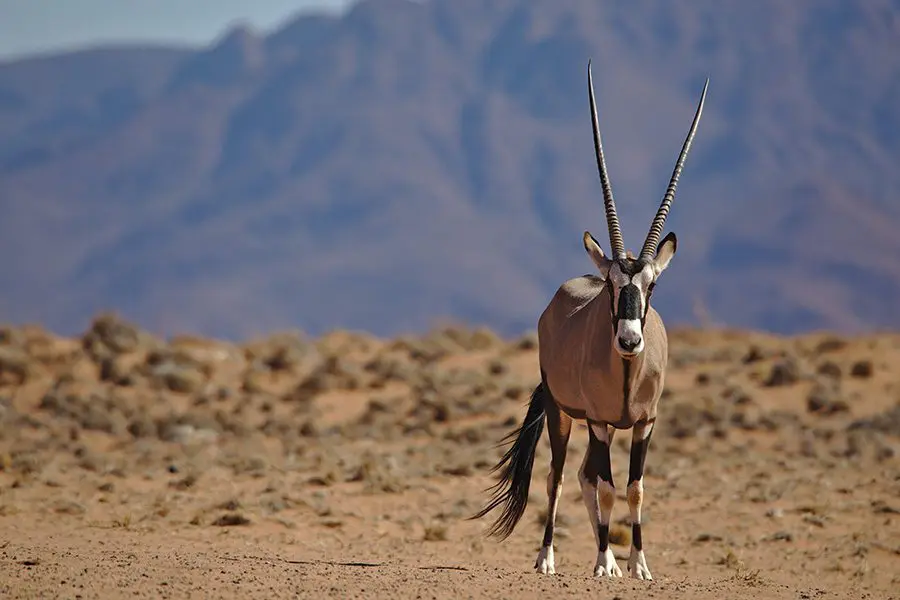
Possibly the most handsome and striking of all antelope species, the oryx is striped and tan in colour with two horns set atop its head. The large antelope's unique appearance and successful adaptation to Namibia's harsh conditions has easily solidified it as the country's national animal.
Where Can You See Oryxes in Namibia?
With a population of 373,000, spread out all over the country, you are likely to spot oryxes anywhere you go in Namibia. In fact, they are so common in the Southern African country that you have a good chance of spotting them on the side of the road after arriving. But as prevalent as they are, little beats the view of an oryx on the dunes of Sossusvlei as the sun rises in the background.
Afrikaans Name: Koedoe
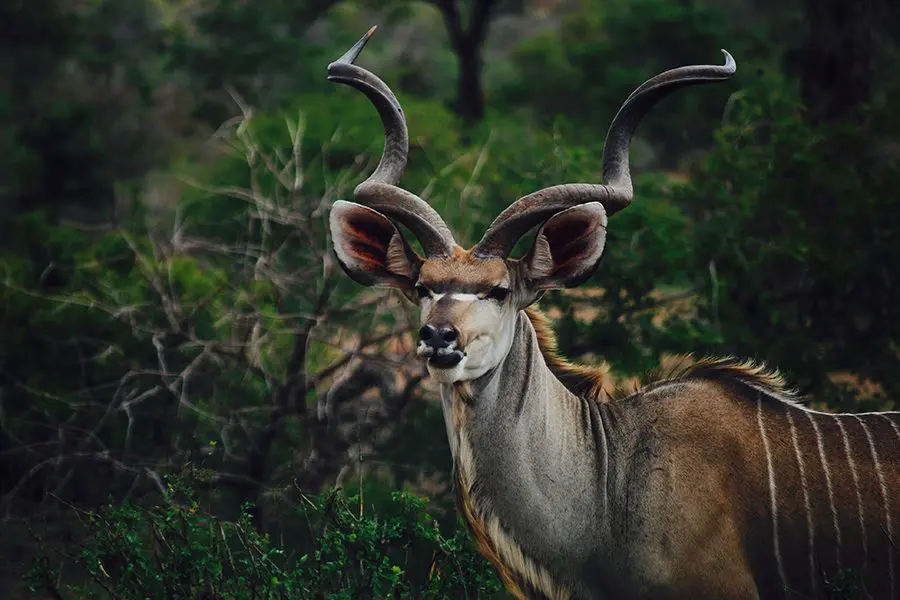
Kudu, also known as the greater kudu, stands as the second tallest antelope on the African continent, bearing long, spiral horns and manes of long hair that reach from the back of their head down to their tail. Despite the large build of this majestic species, kudus are light in build and are known for their leaping prowess – enabling them to jump over fences and other obstacles with ease.
Where Can You See Kudus in Namibia?
Kudu can be found throughout central and northern Namibia. They are especially prevalent on commercial farmland and in game parks all over central Namibia, particularly in Windhoek and Etosha National Park.
Afrikaans Name: Springbok
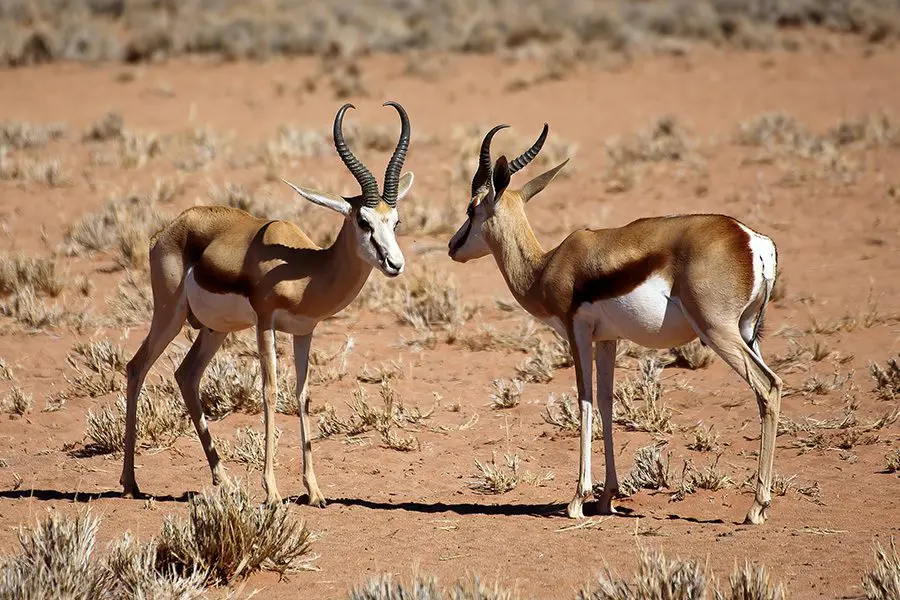
Springboks are so widespread throughout Namibia and South Africa that the latter country has appointed the nimble antelope as its national animal. They are best known for their graceful jumps – which see them take off into bouts of repeated high leaps into the air, getting up to 2 metres (7 feet) off the ground. These beautiful creatures are also built for harsh and unpredictable environments, like dry riverbeds and short-grass savannas – making the arid landscape of Namibia the perfect home for them.
Where Can You See Springboks in Namibia?
As they are Namibia's most abundant antelope species, you are more than likely to spot a springbok during your safari trip. Large herds of springbok can be found in the Namib Desert and central Namibia, particularly on farmlands around Windhoek, as well as in Etosha National Park and Namib-Naukluft National Park.
Afrikaans Name: Olifant

Even though the desert-dwelling elephants of Namibia are no different in any way from their bush-dwelling counterparts when it comes to their subspecies, they are unique in many other ways. Desert-adapted elephants display different learned behaviours and physical traits to thrive in the harsh, arid environment. For instance, where the typical African elephant tends to leave a trail of destruction in its wake, desert-adapted ones are far gentler, taking care not to damage trees and bushes, as vegetation is sparse. These gentle giants also have smaller bodies and longer legs, as well as noticeably larger feet to give them better traction in the sandy terrain. And desert-adapted elephants are also able to survive for days on end without water, whereas savanna elephants cannot.
Where Can You See Namibia Elephants?
Desert-adapted elephants can usually be spotted in Namibia's northern regions. Damaraland and the Skeleton Coast National Park see the highest rates of sightings.
Afrikaans Name: Sebra

Namibia is home to 2 of the 4 species of zebra that can be found in Africa – Hartmann's zebra and Burchell's zebra. To tell the two apart, look out for feint brown lines alongside the famous black stripes – a characteristic unique to Burchell's zebra. A favourite prey of lions, Namibia's zebras are perfectly adapted to survive and thrive in the hot, dry environment.
Where Can You See Zebras in Namibia?
Burchell's zebras are widespread and can be found all over the country, while Hartmann's zebra keeps to the rocky terrain of western Etosha National Park – where you can also see both species in the same space. Namib-Naukluft National Park is also a good destination to see zebras.
Afrikaans Name: Kaapse Buffel
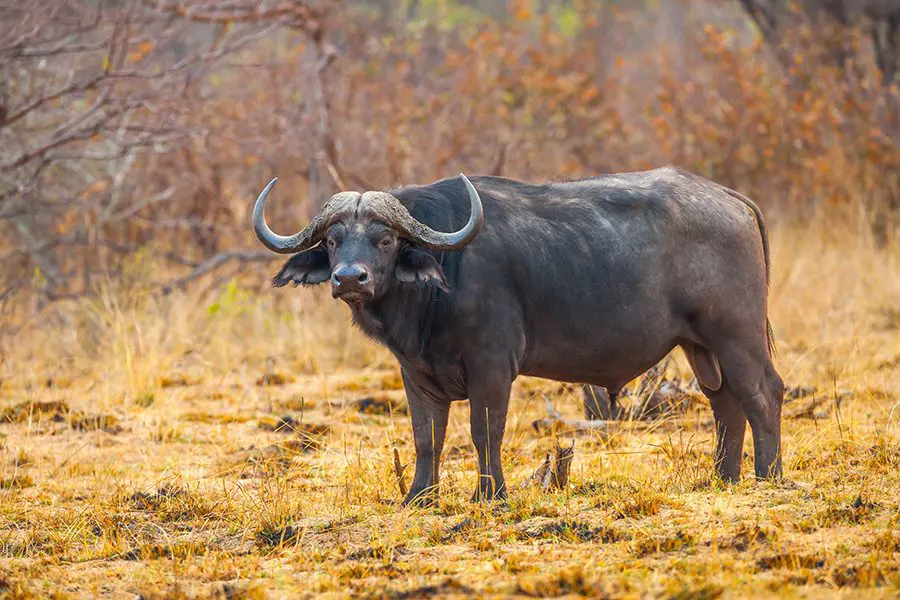
Being one of the Big 5, the Cape buffalo is on everyone's must-see safari list. The heavyset, ox-like animal is large with strong, thick legs and front hooves that are larger than its hind, as well as a huge head and bulky neck. Topped off with massive horns, this gregarious creature is as majestic to see up close as it is intimidating in stature.
Where Can You See Cape Buffalos in Namibia?
Today, Namibia's population of Cape buffalo is meagre compared to what it used to be. This means that spotting these African bovines here is rare, with almost all Cape buffalo sightings concentrated in the Caprivi Strip – a geographic salient protruding from Namibia's north-eastern corner.
Afrikaans Name: Wilde perd
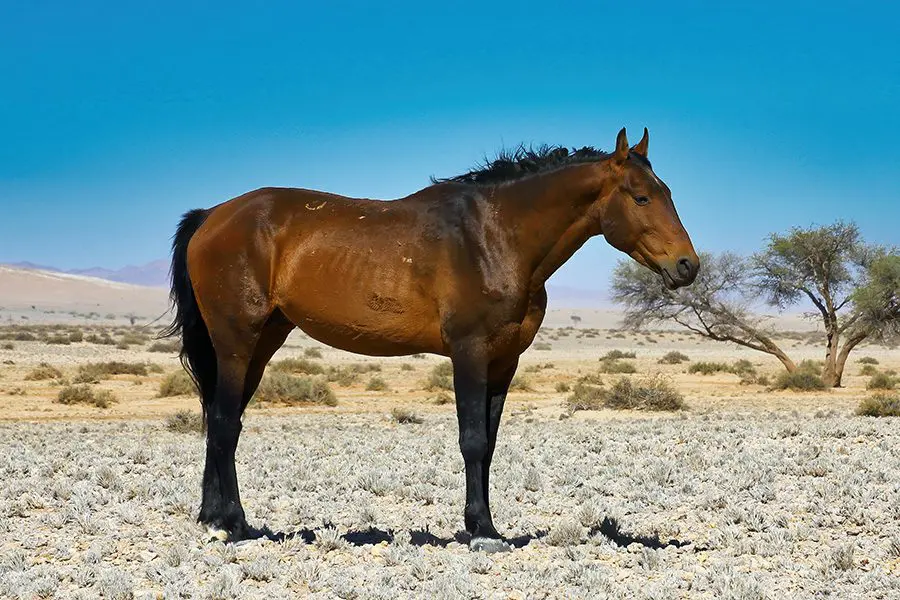
Also known as the Namib Desert Horse, the famous wild horses of Namibia have been roaming the arid plains of the Namib Desert for decades. They have successfully conquered the harsh ecosystem as their habitat and have become one of the most sought-after Namib Desert animals to spot on safari. One of the country's most unique and popular attractions, these small, feral groups of horses are the only horses of their kind in Africa, successfully living independently of humans. In other words, these are a few steeds you won't want to ride.
Where Can You See Wild Horses in Namibia?
The Namib Desert is where you'll find wild horses in Namibia, particularly around the Garub waterhole in Namib-Naukluft National Park.
Afrikaans Name: Leeu
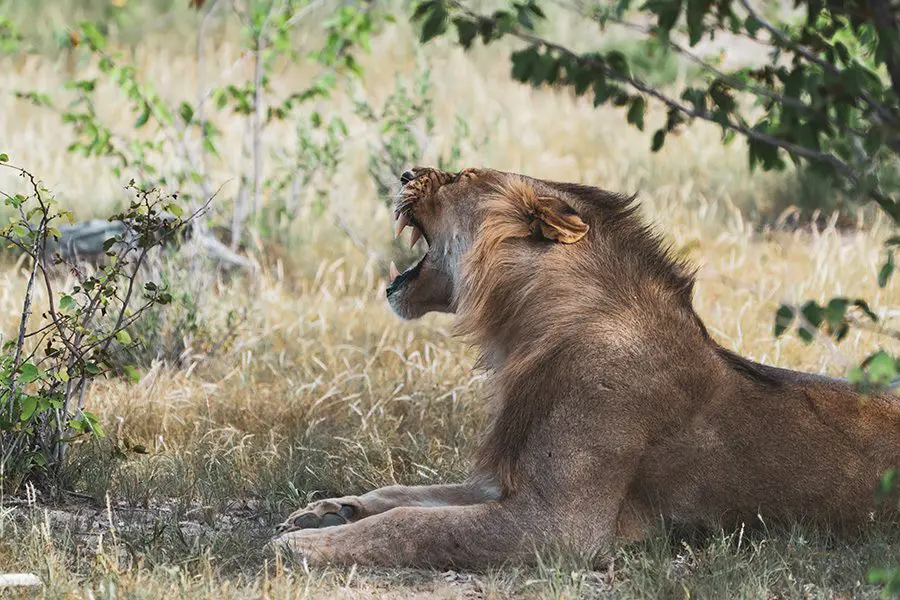
We often picture lions among acacia trees and rolling savanna – not running up mountainous sand dunes and hunting seals along beaches. This is the life of desert-adapted lions. Namibia is the only country in the world where lions have not only adapted to survive in desert conditions but also thrive in it. These hardy survivors differ only from their bush-adapted counterparts in behaviour. Desert-adapted lions tend to have smaller prides, larger home ranges and can travel long distances without water. They also do not commit infanticide – a common practice among lions in the bush.
Where Can You See Lions in Namibia?
Etosha National Park is home to Namibia's largest population of lions, while smaller populations can be sighted in the Caprivi, Bushmanland and Kaokoland, as well as Skeleton Coast Park.
Afrikaans Name: Kaapse pelsrob
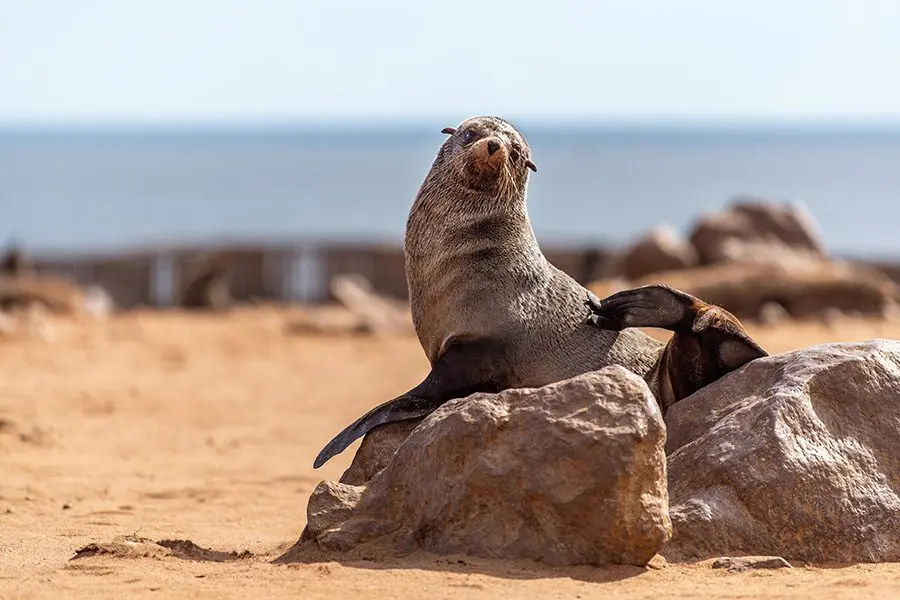
One marine animal you're all but guaranteed to see during your time on Namibia's coast is the Cape fur seal. They are known for their exceptional swimming and hunting abilities, with their closed nostrils and large eyes that can see forward and to the sides providing a distinct advantage when in the water and on land. But what really distinguishes them from true seals are their external ears.
Where Can You See Cape Fur Seals in Namibia?
Being endemic to the coastline of Southern Africa, Cape fur seals can be found in abundance along Namibia's seaside regions, like Swakopmund and Skeleton Coast National Park.
Afrikaans Name: Gevlekte Hiëna
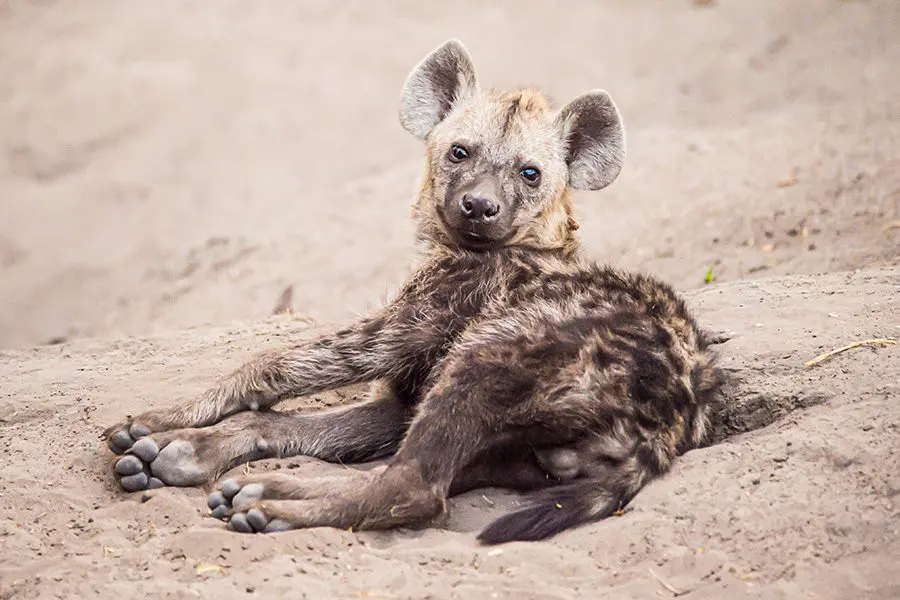
Shenzi, Banzai and Ed, the beloved hyena trio of Disney's 1994 hit film, The Lion King, were inspired by spotted hyenas – right down to the hysterical laughter. Of the three living subspecies, spotted hyenas are the kind referred to as the ‘laughing hyena'. This is because their rapid, loud, and high-pitched whoop calls sound like a giggle or laugh. Brown hyenas seldom make any sounds besides an occasional grunt or snort, while striped hyenas produce vocalisations similar to a chattering sound.
Where Can You See Spotted Hyenas in Namibia?
Spotted hyenas can be seen in Etosha National Park, Kaokoland, the Caprivi Strip, Kavango and Bushmanland regions. There's also a chance for sightings of smaller populations in the Namib Desert and within Skeleton Coast National Park.
Afrikaans Name: Kameelperd
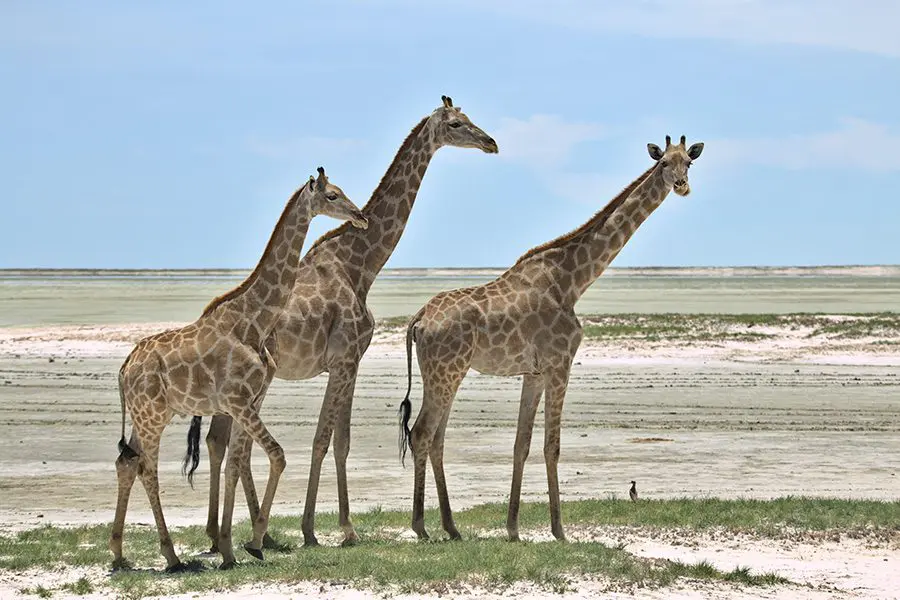
One of Africa's most popular game sightings, giraffes are the tallest of all animals, with most of their height gained from their legs – which can be around 2 metres (7 feet) long – and a tremendously long neck. This large, yet gentle, creature thrives in the desert by being able to close its nostrils completely to keep out sand and dust (a very handy characteristic to have in Namibia) and go without drinking water for many weeks.
Where Can You See Giraffes in Namibia?
Giraffes in Namibia are usually found in the east, south and west of Etosha National Park, as well as on private game reserves in Damaraland and Kaokoland.
Afrikaans Name: Aardvark
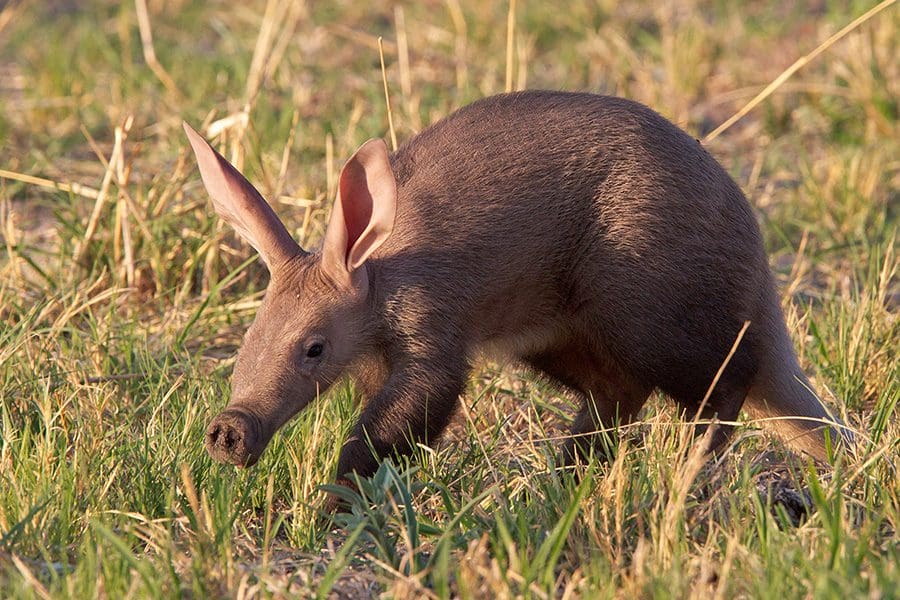
With a name that translates to ‘earth pig', the aardvark is a rather peculiar-looking creature. And besides its long tubular snout – the aardvark's defining characteristic – it does not resemble a pig in any other way. However, the aardvark remains a fascinating mammal that is a sought-after sighting on safari due to its rarity – so if you happen to see one in Namibia, count yourself lucky!
Where Can You See Aardvarks in Namibia?
Except in the Namib Desert, aardvarks are widespread throughout Namibia and can be found in places like the Skeleton Coast, Sossusvlei dunes, Kaokoland and Damaraland.
Afrikaans Name: Aardwolf
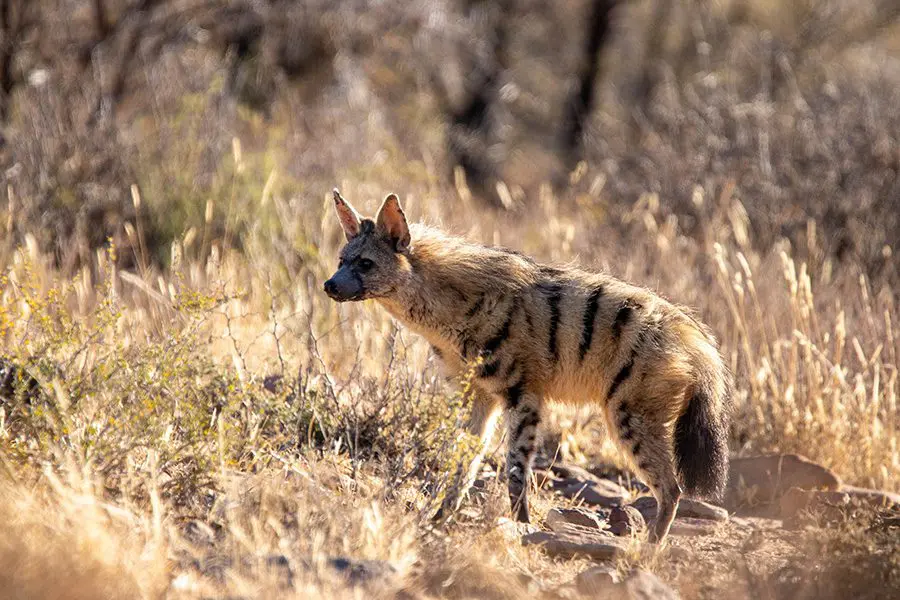
Translating to ‘earth wolf', aardwolves can be described as an unusual type of hyena. Instead of possessing the powerful jaws and strong teeth of a hyena, aardwolves tend to be small, weak and cone-shaped. And it's because of this inability to protect itself from predators that it lives in burrows underground and is predominantly nocturnal.
Where Can You See Aardwolves in Namibia?
Even though they are nocturnal creatures, aardwolves are common sightings in most parts of Namibia's savanna landscape, except for the coastal Namib Desert.
Afrikaans Name: Vlermuisoorjakkals
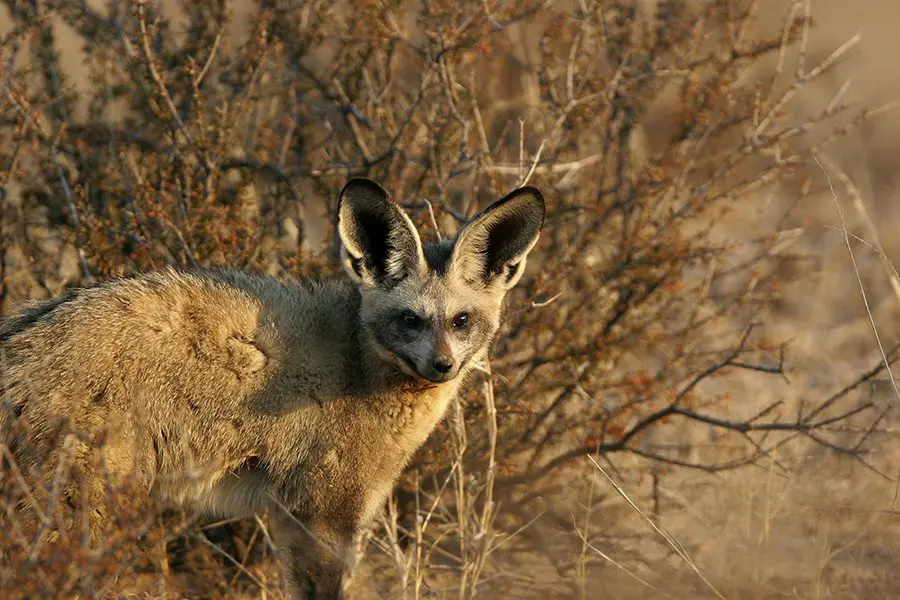
The bat-eared fox's most noticeable characteristic is its large ears that give the creature an almost bat-like appearance. Although smaller than jackals, bat-eared foxes are from the same family and closely resemble the animal. A fascinating fact about them is they are monogamous mammals, found often in groups comprising just a mated pair and their pups.
Where Can You See Bat-Eared Foxes in Namibia?
Bat-eared foxes are widespread throughout Namibia and can be found in nearly every region. They are known to follow the rains in search of abundant insect activity.
Afrikaans Name: Volstruis

These wild birds occur naturally throughout Africa but are particularly well-adapted to thrive in the dry and harsh conditions of Namibia's environment – especially since they can go for long periods without water. Ostriches are giant flightless birds – but what they lack in the air, they more than make up for in speed, reaching over 45 mph or 72 kmph when running.
Where Can You See Ostriches in Namibia?
Ostriches can be found in the northern parts of the Namib Desert, as well as in Etosha National Park, the Kalahari Desert, Windhoek, Swakopmund, and even in the Caprivi Strip.
Afrikaans Name: Meerkat
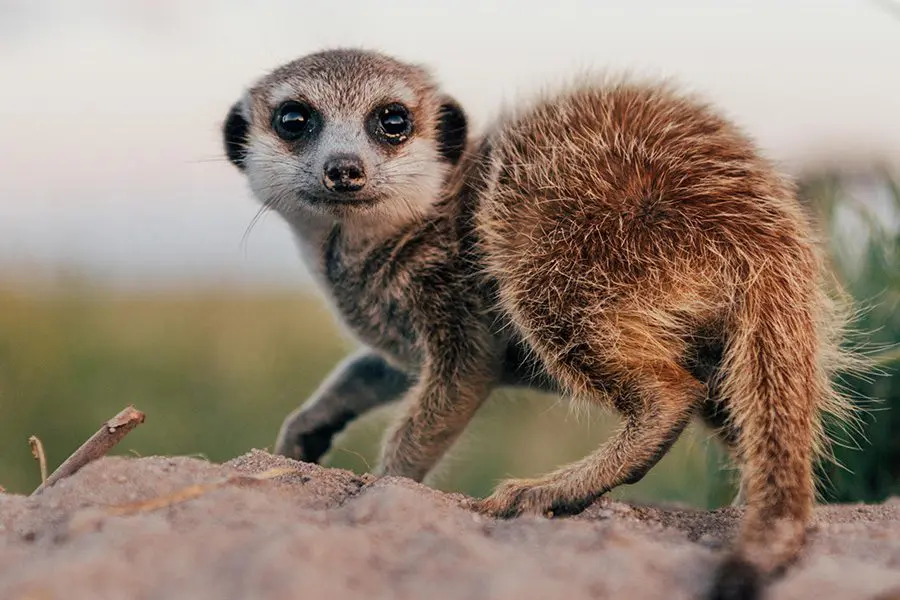
Another inspiration behind one of The Lion King's classic characters (Timon), meerkats are loveable little scamps that will have you ‘ooh-ing' and ‘aah-ing' about their adorableness. Their name translates to ‘ant cat', referring to their ant-eating dieting, as well as their foraging abilities – which sees them burrowing in dry riverbeds, sifting sand and probing crevices.
Where Can You See Meerkats in Namibia?
Meerkats can be found in eastern Namibia, as well as in Damaraland and the Namib Desert.
Afrikaans Name: Brilpikkewyn
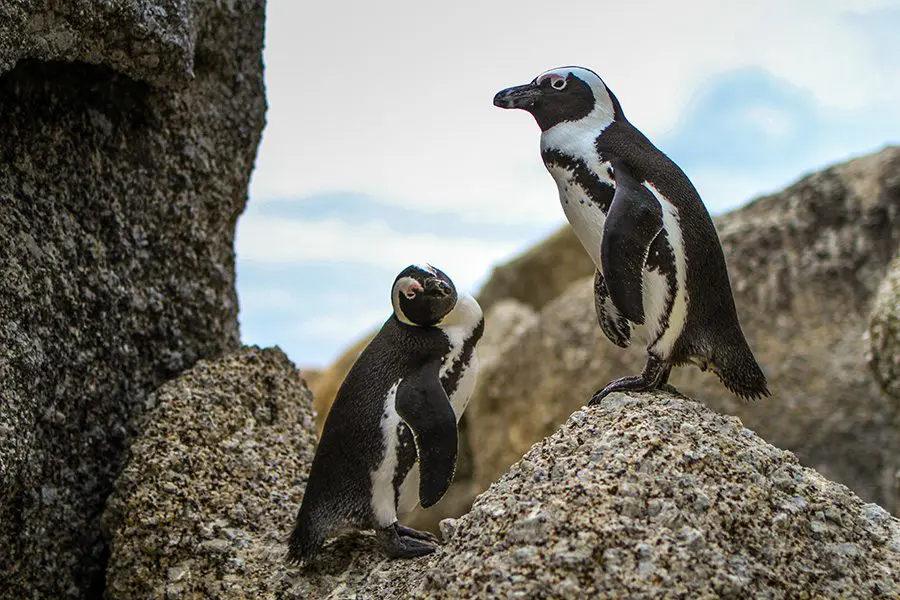
It might sound strange to use the words ‘penguin' and ‘Africa' in the same sentence, but the African penguin is endemic to the southern region of the continent. Also known as the Cape penguin or Jackass penguin, these charming, feathered creatures tend to inhabit inaccessible caves along Namibia's coast.
Where Can You See African Penguins in Namibia?
When visiting Namibia, you have a good chance of seeing African penguins along the coast on Roastbeef Island, Hollambird Island, Possession Island and Penguin Island. As well as in Sandwich Harbour, Swakopmund, Walvis Bay, Cape Cross and Cape Fria.
Afrikaans Name: Blouwildebees

You'd be forgiven if you forgot wildebeest existed outside of the Great Migration in the Serengeti and Masai Mara. They are actually quite common in many parts of Africa, including Namibia. These large creatures might look intimidating and brawny in appearance, but in behaviour, they are agile animals that get a fright quite easily.
Where Can You See Blue Wildebeest in Namibia?
Blue wildebeest are most commonly found in Etosha National Park in Namibia.
Afrikaans Name: Luiperd

The most elusive of the Big 5, leopards are an exciting sighting when on safari, given their rarity. But once you lay eyes on their beautiful coat of black spots arranged in rosettes, watching as they move with the utmost grace and elegance, you'll never be more thankful that you decided to go on safari. They are primarily nocturnal creatures, with daytime sightings usually being of them lazing in the sun on vantage points, like rocks and rocky ridges. The key is to search high when the sun is up, and low when the stars are out.
Where Can You See Leopards in Namibia?
Leopards are distributed across the entire country of Namibia. But if you want to make the experience that much more special, there are several lodges which offer conservation projects, including Okonjima Bush Camp and Okonjima Plains.
Afrikaans Name: Jagluiperd

Cheetahs are one of the most endangered species in both Namibia and the world – which makes seeing them out in the wild all the more special. Being the fastest land mammal, cheetahs can easily reach speeds of up to 105 kmph (65 mph) and are at home in open grasslands, savanna woodlands and the fringes of the desert. What makes them suitable for Namibia's harsh climate is their ability to survive on the moisture from their prey, leaving them with little need for drinking copious amounts of water.
Where Can You See Cheetahs in Namibia?
Fortunately, Namibia is home to a large portion of the world's remaining cheetah population, with sightings in Etosha National Park and Windhoek.
Afrikaans Name: Oorbietjie
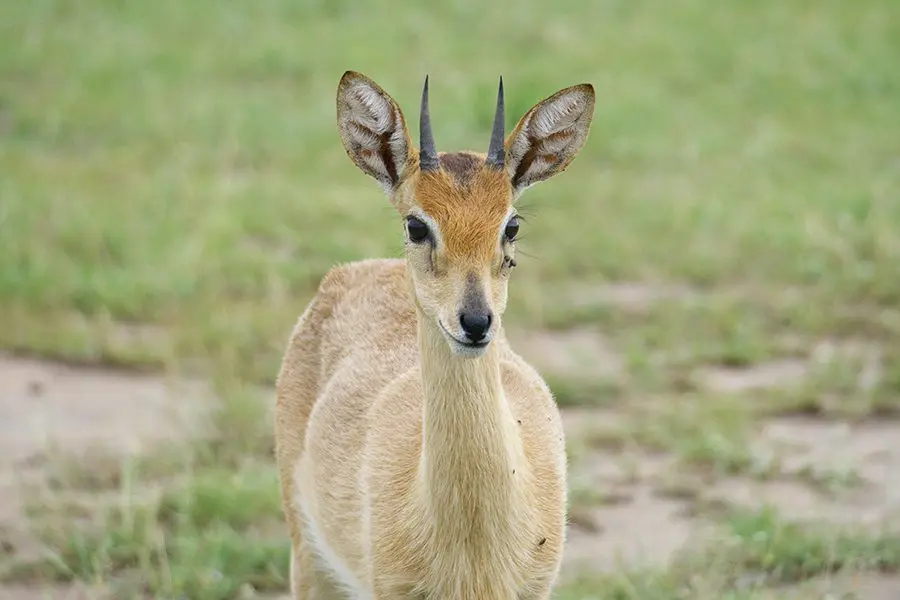
The endangered oribis are small, elegant creatures that are very rare in Namibia and can often be found in the grasslands, floodplains, or lighter wetlands of the country. The antelope species can be recognised by its long neck and limbs with short and erect horns.
Where Can You See Oribis in Namibia?
The best place in Namibia to spot oribis is in the Caprivi Strip.
Afrikaans Name: Afrika Wilde Hond
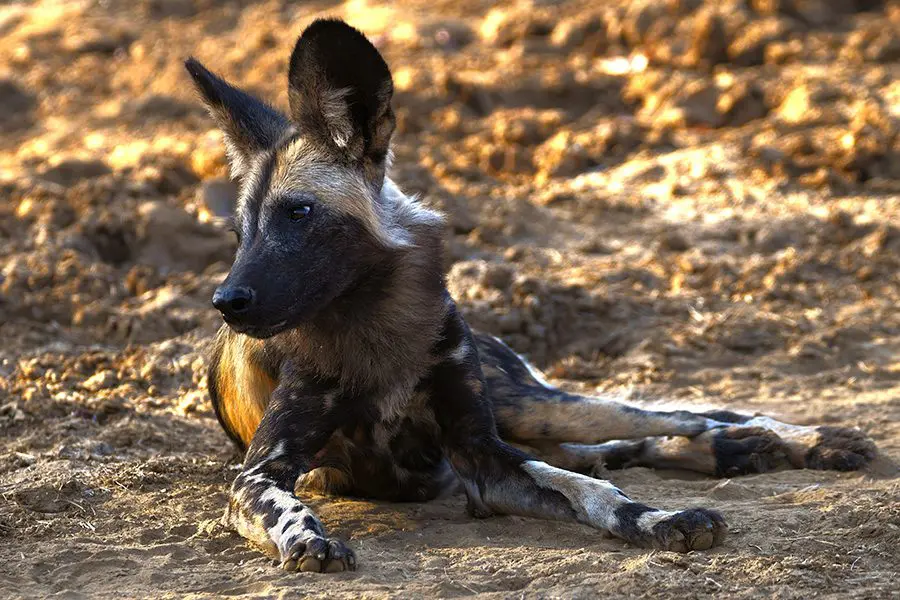
African wild dogs are one of the most compelling animals in Africa yet are also one of the most endangered mammal species. Recognisable by their large, rounded ears, long legs, bush and broad, white-tipped tail, and their beautiful patched coat, the sociable species live and hunt in packs – making them one of the most successful hunters in the wild. Where you see one, you can be sure that up to 20 other dogs are not far behind.
Where Can You See African Wild Dogs in Namibia?
Sightings of African wild dog is rare no matter where you go in Africa, but your best bet in Namibia is visiting Windhoek, Bushmanland, the Caprivi Strip or Okonjima Nature Reserve.
Afrikaans Name: Renoster

Both black and white rhinos were once abundant throughout Africa. Today, they are both on the brink of extinction. Fortunately, not all hope is lost and there are plenty of conservation initiatives and projects working tirelessly to ensure that these majestic giants are around for future generations to come.
The two species of rhino are nearly identical (no, one is not black in colour and the other white), with both being the same blue-grey colour. The only noticeable distinction between them is the shape of their lips. Black rhinos are hook-lipped while white rhinos are wider and square-lipped. Another great way to tell them apart is their foreheads. Black rhinos have a shorter forehead, but a more protruding, smaller head. And white rhinos have a longer, less defined forehead and a longer skull.
Where Can You See Black and White Rhinos in Namibia?
Over 35% of Africa's black rhino population can be found in Kaokoland and Damaraland, while white rhinos can be spotted in Etosha National Park, as well as the Waterberg Plateau Park.
Afrikaans Name: Poekoe
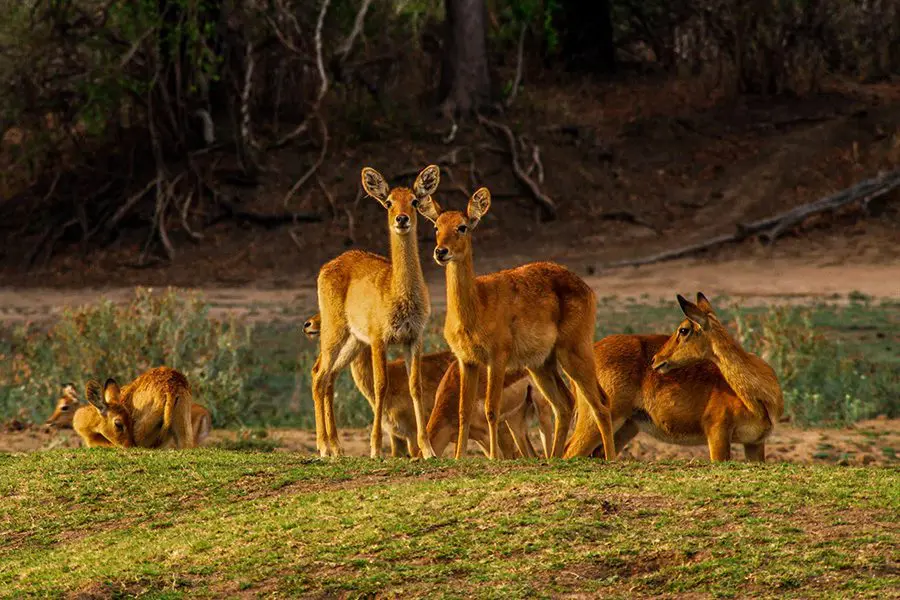
Pukus are medium-sized, stocky antelope that are known to frequent marshy grassland and riverine areas in Namibia. Due to habitat loss, pukus have found themselves on the country's endangered list. Fortunately, you still have a decent chance of seeing them during your trip to Namibia. In fact, you're more likely to hear them before seeing them. Pukus are known to emit a loud, whistling sound that's repeated numerous times in sequence to communicate with one another when something is approaching their territory.
Where Can You See Pukus in Namibia?
To see pukus in Namibia, you'll have to head out to the Caprivi Strip, as well as the Namibian side of the Chobe River.
Afrikaans Name: Ratel
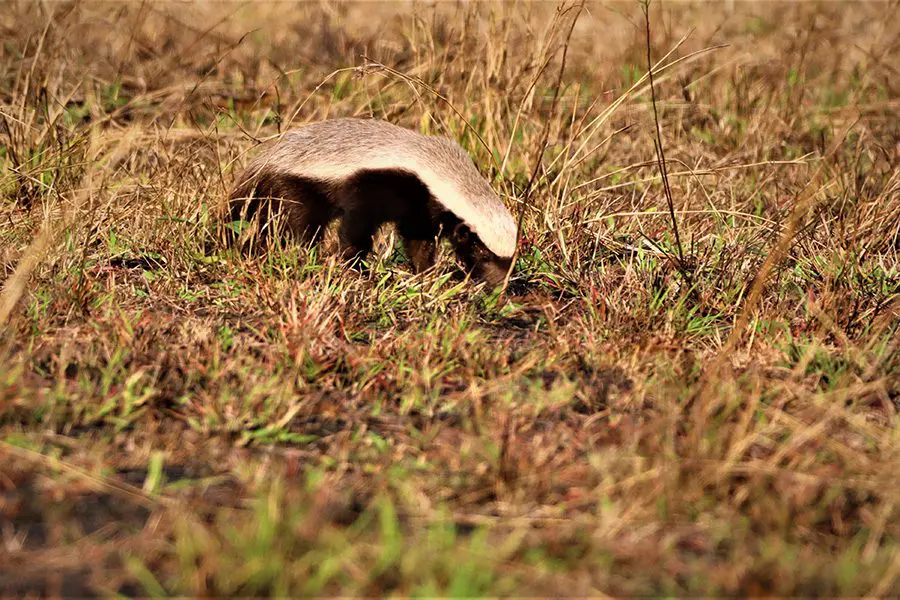
Almost exclusively operating between dusk and dawn, these nocturnal creatures are one of the most difficult animals to spot on safari. But if you're one of the lucky ones to see them, know that you're part of a select few. These fascinating animals are about the same size as a European badger or medium-sized dog but are one of the most ferocious creatures when under attack – attacking animals as large as buffalo. Their long claws and thick, loose skin protect them from stings and bites, while special glands emit a foul-smelling liquid that is off-putting to any predators or enemies.
Where Can You See Honey Badgers in Namibia?
Honey badgers can be found almost everywhere in Namibia, despite the association that they are difficult to spot on safari. Etosha National Park is a particularly great place to try and see honey badgers. The only area where you won't find honey badgers in Namibia is in the Namib Desert.
Nothing beats a classic game drive in 4×4 vehicles through Namibia's wildlife-rich regions, but there is more than one way to experience the wilderness on safari:
| Activity | Best Place to Do It |
|---|---|
| Hot-air Balloon Safari | Sossusvlei Swakopmund |
| Nature Walks | Sossusvlei Damaraland NamibRand Nature Reserve Etosha |
| Horseback Safari | Sossusvlei |
| Dune Climbing | Namib Desert Sossusvlei |
| Self-drive Safari | Namib Desert Sossusvlei Swakopmund Etosha National Park Damaraland Skeleton Coast Kaokoland |
| Quad Bike (ATV) Safari | Sossusvlei Skeleton Coast NamibRand Nature Reserve |
| Mountain Biking | Sossusvlei |
| Boating Excursions | Kaokoland Swakopmund |
| Dune Boarding | Skeleton Coast Sossusvlei |
| Culture Experiences | Damaraland Kaokoland |
| Scenic Flights | Sossusvlei |
Get in touch with our African Safari Experts to start planning your safari to see Namibia's wildlife in person. With over two decades of experience and knowledge, we are professionals in crafting tailor-made itineraries that are sure to be the trip of your dreams.